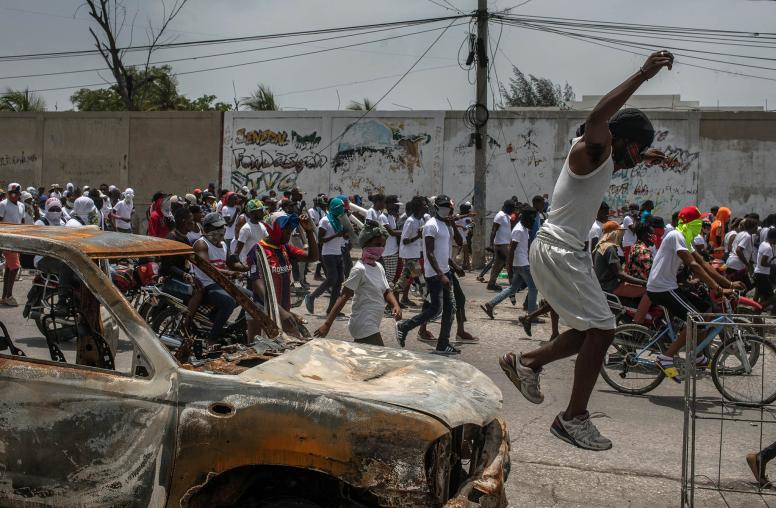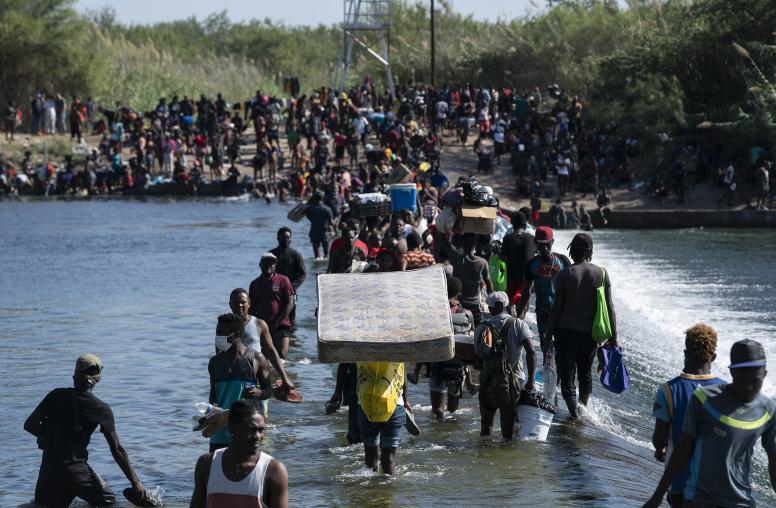Haiti Needs a Political Dialogue Alongside the Multinational Security Mission
While the U.N.-approved mission will help stifle gang violence, Haiti’s humanitarian crisis requires a full governance reset.
This week, the U.N. Security Council voted to send a multinational armed force to Haiti in the hopes of addressing the beleaguered Caribbean nation’s rampant gang violence and instability. While there is not yet an official timeline for its deployment, the Kenyan-led force will face a complex security environment — one that has been made all the more daunting by Haiti’s ongoing political turmoil. Whether the mission succeeds will hinge not only on the deployed force’s ability to quickly establish peace, but whether or not it can pave the way toward a meaningful and democratic government reset in the historically tumultuous country.

USIP’s Keith Mines explains the U.N. decision to authorize the mission, the challenges it will face once on the ground in Haiti, and how the United States can facilitate a simultaneous political dialogue to give Haiti a chance to reestablish secure and stable governance.
Why did the U.N. authorize this mission and what will it do?
In October 2022, the Haitian government sent a letter to the U.N. secretary-general requesting a specialized armed force be deployed to stop the country’s ongoing humanitarian crisis caused by criminal gangs and their sponsors. The Haitian government envisioned this force would establish a safe environment that would allow hospitals and schools to function, food and water to be distributed, and reopen the free movement of people and the resumption of commerce.
In the year since this letter was sent, the situation in Haiti has deteriorated further. In July 2023, a U.N. secretary-general report cited 2,094 homicides on the year — an increase of 67 percent from 2022. Meanwhile, half the country’s population remained food insecure and 200,000 people were internally displaced. Haitians born in the Duvalier period (1957-1986) have told me this is the worst they have ever seen the country, with gangs controlling as much as 90 percent of the capital Port au Prince and the police ineffectual in stopping their violent predations.
Earlier this week, the U.N. Security Council passed a resolution on Haiti put forward by the United States and Ecuador by a vote of 13-0, with Russia and China abstaining. The resolution clears the way for Kenya to lead an international force that would deploy to Haiti and work with the Haitian National Police to confront the gangs and protect critical infrastructure.
Several other countries — the Bahamas, Jamaica, Italy, Spain, Mongolia, Senegal, Rwanda, Belize, Suriname, Guatemala, Antigua and Barbuda, and Peru — have also announced pledges of support. The United States has offered $100 million in financial support for the force and another $100 million to enable intelligence, equipment and logistics operations.
In August, a Kenyan scoping mission went to Haiti to review the mission’s requirements. Kenya will send a contingent of 1,000 from its border police, which has extensive experience in peacekeeping operations, and will provide leadership of the overall mission.
What are the challenges facing the mission?
Kenya has expressed not only a willingness to lead the force but a firm determination to make the mission succeed. Such coalitions have been successful in the past, notably in East Timor from 1999-2000, when Australia led a multinational U.N.-mandated (but non-U.N. force) to address the humanitarian crisis and provide security until a U.N. force could arrive.
Other U.N.-mandated international security missions conducted outside the conventional U.N. peacekeeping apparatus were led by the United States and NATO, including two previous missions in Haiti.
Still, this latest Kenyan-led force will face a number of challenges in establishing itself in Haiti.
First, there will be resistance by some Haitians to having yet another international security force in their country — especially given the legacy of past forces, which in one case unleashed a cholera epidemic that killed 10,000 and in another case was involved in sexual predation.
Second, past forces came to Haiti with immense size and strength — the 1994 force included 20,000 personnel and the 2004 force was made up of 6,400 soldiers and roughly 1,700 police officers. Featuring military components, fully enabled air support, mobility and quick-reaction elements, these missions created an intimidating presence to back up local Haitian police. As a result, violent resistance was minimal and ex-military, gangs and other violent actors were often quick to lay down their arms.
This new force will be smaller and, as planned, will not include military components. Meanwhile, they will be confronting gangs that are better armed and potentially more resistant than in the past.
Third, this new force will not have a natural connection to the communities it will be working in. Kenya has extensive experience in these kinds of gray-area operations and their personnel will be a quick study on what is required to succeed. But there will still be language barriers, culture clashes and the inevitable civilian casualties that will require constant engagement to overcome. The force’s ability to quickly establish dialogues with civil society on security issues will be important. They will also need to establish connections with gangs that may be willing to disarm and allow for a peaceful way forward, as opposed to gangs who will need to be engaged by force.
But the most significant challenge, and the true center of gravity for success or failure, is the political environment inside Haiti. Many fear that in the current environment, the force will simply be propping up an unelected and unpopular government that will not provide the support needed to build a new police force and match the efforts of the international force with effective governance.
As Haitian civil society leader Pierre Esperance said in a recent op-ed: “Another international force in Haiti will never work without a functional government in place.” Alongside deploying a security force, the international community will also need to engage in a political effort.
What role can the United States play?
In addition to offering full financial and enabling support for the multinational effort, the United States will be the key player in any effort to reset the transitional government in Haiti. To many, U.S. support for the current government is the only reason it can hold on to power.
There are many challenges involved in a government reset, but there are also a number of good proposals on the table for how it might be done. To date, efforts have been technically sound and have drawn in a host of different players, including the ongoing effort by the Caribbean Community’s Eminence Group. But they have all fallen short thus far, as none have the leverage needed to coerce all parties to make the concessions required to develop an effective governing body.
Some analysts and Haitian civil society leaders are calling for an arrangement similar to the Council of Sages, which was used in 2004 after then-President Jean-Bertrand Aristide gave up power. In that case, Haitian stakeholders selected five prominent individuals to form an executive body, from which they selected one member as the acting president. Other institutions were then formed in temporary fashion to flesh out the rest of the government and carry on with basic governance until elections were held two years later.
Getting to this kind of arrangement today would best be done by convening a national reconciliation conference. There are roughly a dozen key political movements that would need to be present, as well as civil society, the business community, religious actors and the current government. Given the already extensive work of the Montana Accord to build a broad-based coalition, they would be a key representative element for such a convening. Seats at the table would likely range between 20 and 30, with another 30 or so at a second table or participating in consultations.
While such a convening could be held in a Caribbean country, many argue that for the sake of symbolism it would be best to hold it in Haiti’s relatively safe northern region, perhaps Cap Haitian with its rich history and status in the country’s struggle for independence.
Tickets to the gathering would need to be one-way. It should be conducted in an open-ended structure with the idea it would not end until there was an agreement (at which point, of course, there would be a return ticket). Outliers and non-participants would be able to join during the proceedings, with international and Haitian champions being allowed time to provide incentives for all to join and for full concurrence on conclusions. All options for government formation would need to be on the table, and all actors would need to be willing to step aside to accede to the will of the participants.
While many other countries would need to help at this point, especially Haiti’s friends in the Caribbean and the Americas, only the United States would be in a position to provide the critical inducements to ensure all key parties were willing to abide by the conference’s decisions. But it would need to do so well in the background.
If a newly formed transitional government could take office before the end of the year, it would be in a position to support the incoming force in the long work of resetting security, and together could succeed in giving Haiti a new chance at security and stability.

